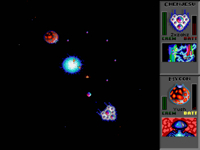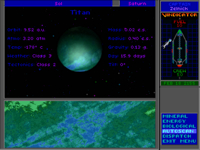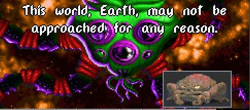May 04, 2005
 Playable Classics: Star Control II
Playable Classics: Star Control II
by peterbI first encountered Star Control on the Sega Genesis. At the time, there wasn't anything to indicate that it would eventually lead to one of the best computer games I'd ever play.
"I must destroy you...for the children!"
The first game in the series was fun. Not Earth-shaking, not life-changing, but fun. It was, at heart, a dressed up version of the classic Spacewar game: meant for two players, each player controls a ship and tries to blow the other one out of the skies. They added to the classic formula by giving each ship unique weapons and powers as well as a unique look, handling characteristics, and a backstory in the manual explaining a little bit about the species that was flying it.
Each ship had a primary weapon and a secondary fire mode which often affected the enemy's mobility. For example, the VUX Intruder had a powerful but very short range laser. It's secondary fire mode was to release slow-moving blobs that tracked its opponent and, when it made contact, slowed him down substantially. The Chenjesu Broodhome fired long range missiles that could be detonated remotely and had a secondary fire mode where it released a device which sapped the enemy's power. The differing ships and weapons were not just graphical flourishes, but were significantly different. Choosing one ship over another had serious tactical implications.
Around this core mechanic they wrapped a trivial strategic game, a sort of glorified 3D risk. Each of the races in the game was considered to be on one of two teams: the "Alliance of Free Stars" or the "Ur-Quan Hierarchy." Players moved their ships through a hard-to-interpret rotating 3D map of star systems, and when two ships occupied the same system, they fought.
If you think this mechanic sounds similar to the superb classic Archon, you're right. And it's no surprise. One of the principals behind Star Control was Paul Reiche III, who was partially responsible for Archon. Reiche also worked on the seminal (though flawed) Starflight series of games. Starflight involved exploring a huge galaxy filled with interesting and amusing alien creatures and a dramatic, intricate, and slowly-revealed plot. It was engaging and exciting in 1986, but many aspects of the user interface failed to stand the test of time.
Star Control II takes the deep space exploration and epic plot style of Starflight, and marries it to the fast-paced, rock-paper-scissors arcade combat of Archon. The sum is better than its parts.
"Your behavior makes clear the very slight distinction between bravery and suicidal stupidity."
Star Control II starts with humanity defeated, crushed by the Ur-Quan Hierarchy, enslaved and confined to Earth. Through a series of fortunate events, you conveniently find yourself in possession of an immensely powerful alien vessel. You have just arrived in our solar system, and begin trying to find a way to free Earth and, y'know.
Save the Universe.
Saving the Universe, at least initially, involves traveling to many uninhabited planets and mining them for precious materials. Along the way, you'll find strange items. You'll see wondrous celestial objects. And you'll meet intriguing alien races who are by turns frightening, amusing, hilarious or irritating, and you'll kill some of them.
Your immensely powerful alien vessel can be used in combat, but if you lose it, the game ends. Fortunately, you can carry up to 10 smaller ships (with the aforementioned different strengths and weaknesses) to be used in combat on your behalf. This keeps combat interesting. Combat isn't, to my mind, the real point of Star Control II, though. The real point is talking to the aliens.
"It turns out that in their last lives, the Ilwrath were all shining beings of pure light and blissful love. They had reached the pinnacle of spiritual evolution and could go no further. They were perfection. And then, somehow they got just a tiny bit better and WHAM, they were all of a sudden totally evil. Wouldn't you know it, get too perfect and you wrap right around to evil."
It's difficult to talk in detail about the aliens in Star Control II without giving away details which would spoil the plot. There are a wide variety of them, vividly realized in very simply animated illustrations and enjoyable dialogue. The conversation trees are not unlike those you encounter in Jade Empire, although they're a little less safe. If you choose to be belligerent in the wrong place, the consequence could be losing a valuable ally in the war against the Ur-Quan.
The Ur-Quan themselves are superbly-depicted bad guys. They look a bit like Cthulhu, but somewhat meaner. They're highly intelligent, and highly motivated. This is one of the reasons I love the game so much. I love a game with enemies I can respect. The Ur-Quan aren't evil. They're just very, very motivated to prevent certain things from ever happening again, and have decided that conquering every sentient species in the Universe is the best way to achieve their goal.
The balance in dialogue is weighted towards comic relief early in the game and gets progressively more serious as the plot develops, although you can always find a bit of the absurd lurking somewhere, if you look hard enough.
The writing is good throughout. It ain't Dostoevsky, but it serves the tone of the game perfectly. The funny parts will make you laugh out loud, and the serious parts will make you think.
"Oh no! It's one of those ultra-gross humans again! Quick, hide your eye! AGGH! Look at the pulpy red thing in its mouth, how it wriggles and writhes like a wet blood worm and plays over the hard white nubs that protrude from its headbone! I think I'm going to be sick."
The universe of the game is immense. There are just under 500 star systems, all of which can be visited, most of which have planets, sometimes many planets. Many of these don't have anything to do with the main plotline, but the fact that they are there lends an open-ended feeling to the game that others have been striving (and failing) to emulate ever since. Yet the game is scripted such that it's almost impossible for you to simply be a lost wanderer, not sure of what you can or should do next. If you decide to disregard the plot and go noodling through obscure corners of the galaxy, it's because you are choosing to do so, not because you're lost.
The stars are all named after real stars, which is nice. Their actual locations have nothing to do with the real sky. I think I can forgive that.
The original game is not even remotely playable on Windows or Macintosh. How, then, can I designate this to be a Playable Classic?
In 2002, the creators released the source code to the 3DO version of the game as open source software. A group of dedicated fans took that code and created a fully-realized, multi-platform, OpenGL game called The Ur-Quan Masters (the Star Control name could not be used because it is trademarked). The game is available for Windows, Macintosh, and Linux. The original soundtracks are available for the game, as are the recorded voiceovers for all dialogue, which are quite good. This adds an extra dimension over the MS-DOS version that I played in 1992. There are 50 slots for save games. You can save any time you're not in combat. You can play fullscreen, or in a window, at any number of resolutions. It works great."Now I am certain that you are an honest and friendly being who is forced entirely through unfortunate circumstance — the unreasonable hostility of the Universe — to travel the galaxy in a ship which, according to my sensors, is best suited for conducting planetary-scale genocide."
So in The Ur-Quan Masters we have a better than picture-perfect port of one of the best games ever developed, available for free, that runs on all major software platforms.
Truly, we live in miraculous times.
The Ur-Quan Masters can be downloaded for free at Sourceforge. (Update: psu was my Mac guinea pig and says that Mac users should download the "unofficial" version here, because it is a more turnkey install. Also, if you're on Mac OS X 10.4 ("Tiger"), make sure the "OpenGL" box is checked.)
If you are trying it for the first time, I truly envy you. You are about to play a game that you will remember for the rest of your life.
Enjoy!
Posted by peterb at May 4, 2005 09:38 PM | Bookmark ThisI must say I loved that game. Heck, I have the 3do music in my iTunes playlist.
Posted by Roman Mitz at May 5, 2005 08:10 AMIf you want a more turnkey install for the Mac, go here
http://www.submedia.net/uqm/
The sourceforge page points you to a binary install that does not have any of the required auxilliary frameworks.
The dmg in the above location is more complete.
Posted by psu at May 5, 2005 11:04 PMThe Ur-Quan Masters is great! Be sure to check out the all-new music remix packs:
http://www.medievalfuture.com/precursors/
Hi. As a SC2 freak, I feel like I should give some advice to new players. One, if possible play a couple of games of Star Control I to get a feel of things. Two, definitely keep a pen and paper handy. Three, maximize your ship's speed. Four, NO walkthroughs!
Posted by Kizor at July 5, 2005 03:46 AMI _absolutely_ loved SC1 and SC2. The feel was great. There was adventure, aggravation, suspense, horror, fear and discovery. But my memory failed me once again.
I remember the graphics being so much better. Here I am playing SC2 on my brand new AMD fx-57 / nvidia 7800 GTX god box. Someone laugh. Ur-Quan masters runs great on windows. On mac I get only video garbage although this site might have the fix, I didn't play with it too much. That's what the weekend is for.
All I know is that this open-source project has really brought me back. I'm glad this page says '1992' explicitly, I could only place it between 1991-1994. I played UQM right before I went to bed and couldn't fall asleep. Dumb move. I just laid and thought about how much the world has changed, my life has changed since SC2/MSDOS. I mean ... no Internet, no gamefaqs.com, no IRC, no blogs, not even SVGA (a term that is gone now). When I beat SC2, I beat it by myself. I think I asked for help on how to beat the very, very end (not going to give anything away) ... I had no clue. I think I asked a friend or read it on a BBS. Can't remember. When I beat it this time around, I'm going to have HTML, tabbed browsing, live chat, dual head, wireless and a whole bunch of other technologies all at my fingertips to make a gamer win.
What an age we live in indeed.
The intro graphics of SC2 were amazing in the day. The fading/transitions were incredibly high-quality. Seeing them again made me realize that gaming standards are very high these days but not in terms of gameplay. The PSP can do ad-hoc networks with my friends but no decent games (yet ... like a real RPG).
The space sim is dead. X3:Reunion is the only thing I have to look forward to in that genre. People want fighters, FPS games, RTS because it's all 3d. It's all 3d now!
Wing Commander was pixel 2d graphics. The artists knew what they were building. A video cartoon. Now 3d modeling raises the bar. I have to skin stuff. I have to scale my model back for the PC hardware. I have to worry about the player camera. I spend my time managing the 3d world and it looks less like a 2d cartoon or movie-set. In my opinion, very few games have captured the look/feel/interface/response that Wing Commander and Star Control 2 had. And I think it's because everything has gotten more complicated and unmanageable.
My comments are very general. There are good 3d games out there with some clever design, style and decent gameplay (HL2, Rise of Nations, Jedi Academy, WoW, Psychonauts). But it's not the same. Not until someone explicitly tries to stay 2d. Like Viewtiful Joe, not that I played it.
Anyway ... UQM = metal. \m/
Posted by Milkfilk at September 9, 2005 02:36 PMsuch a fun game! I played it as a little kid (like when I was seven), but never got very far- it was my dad's game- and a bit too complex for a seven year old. When I found it on the internet a year ago, I was ecstatic. I had such fond memories of watching my dad play. Now I finally got to win the game myself!
Posted by jane at October 14, 2005 02:04 PMIf you like to play classic computer games, I suggest you checkout Download Classic Abandonware Games. It's a really huge Archive of all the old classics from the C64, Amiga and PC.
Happy Gaming, Jessica
Posted by Jessica at January 11, 2006 02:56 PMPlease help support Tea Leaves by visiting our sponsors.


